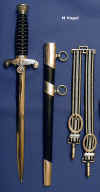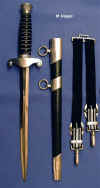|
Customs Service [Zolldienst]
In many ways this formation was an extension of the long arm of the Gestapo, eventually all customs departments came under full control by the Gestapo in October 1944. In order to accomplish its diversified missions, the German Customs Service was organized into two separate groups: 1)… Landzoll - Land Service. Guarded land borders, import control, tax gathering, border security. 2)… Wasserzoll – Water Customs, sea fronts, harbours, ports, imports by sea, security. Custom detachments ranged in size from small guard posts of five men to large 450-man groups in Hamburg and Markdorf. At the outbreak of WWII, the customs officials became more like border police, greater emphasis being placed upon border security. The responsibility of the Zolldienst was expanded to include border control of escaped prisoners of war, saboteurs, defectors, refugees, spies, etc. The uniform of the Customs officials was similar to the Heer uniform hence the similarity of the dress dagger. |
||||||
Dagger Information – Land Customs In July 1937 Reich finance minister, Lutz Graf Schwerin Von Krosigk, introduced a plain 41 cm dagger for wear by Landzoll officers from the rank of Oberzollsekretar and above. It was similar to the Heer dagger created 2 years previously, an eagle with out spread wings on the cross guard. The talons of the eagle held an oak leaf wreath with a swastika at its centre, also similar to the Heer dagger. The grip had a wooden core which was covered in dark green leather, a twisted wire threading its way in a clockwise direction down the grip with 10 rotations. The pommel was like the Heer dagger, surrounded by vertical oak leaves. The scabbard was steel and wrapped with dark green leather, same as the grip. The scabbard had a slight taper from the top to the bottom with all three scabbard fittings having a diagonal shape. Initially all fittings were die struck in nickel silver or nickel plated steel. From 1938 they were cast from aluminium which resulted in the fittings lacking in definition when compared to the pre 1939 units. The dagger was suspended from a double strap velvet hanger with green facings with Heer style round buckle. A 42 cm aluminium Portapee completed the accoutrements. Junior officers had a Portapee with green stripes on the acorn. The dagger was discontinued in 1942. The principal manufacturer of the Land Customs dagger was Carl Eickhorn.
|




